#Wilhelm von Humboldt
Text
Todo lo expresado forma lo inexpresado o lo prepara.
—Wilhelm von Humboldt, «Sobre el estudio comparado de las lenguas en relación con las diversas épocas de su evolución» en Escritos sobre el lenguaje. Traducción de Andrés Sánchez Pascual.
#wilhelm von humboldt#escritos sobre el lenguaje#über das vergleichende sprachstudium in beziehung auf dir verschiedenen epochen der sprachentwicklung#andrés sánchez pascual
7 notes
·
View notes
Text
Ohne Sicherheit vermag der Mensch weder seine Kräfte auszubilden noch die Frucht derselben zu genießen; denn ohne Sicherheit ist keine Freiheit.
Without security man can neither develop his powers nor enjoy the fruit of them; because without security there is no freedom.
Wilhelm von Humboldt (1767 – 1835), German scholar and statesman, founder of the Berlin university
23 notes
·
View notes
Text
The session of plenipotentiaries that never happened,
Or The tale of how I rediscovered that one lithography of Isabey’s famous painting in extremely high resolution and went through a total recall, so that everybody could suffer (myself including) ⭐️
The arrival of the Duke of Wellington had not only affected Vienna's diplomatic activity and social calendar; it was also posing a problem to the painter Jean-Baptiste Isabey, who was trying to capture the congress on canvas. He had been working for some time, and he had finally found a way to balance all the strong personalities, many of them patrons, into one single painting, and yet not offend national sensibilities or fragile egos.
The painting, which depicted the delegates gathered in a conference room, turned out to be a compromise in the best spirit of Vienna diplomacy.
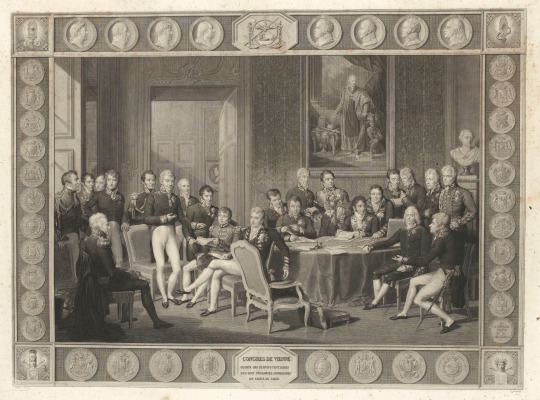
Metternich, the president of the Congress, draws the eye, as the only standing figure in the foreground.
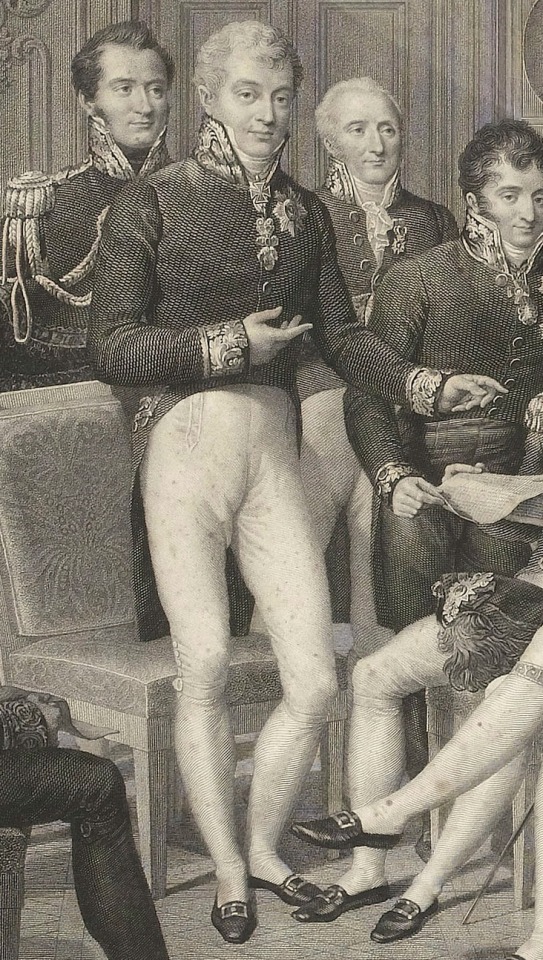
Castlereagh, though, commands the center, sitting with his legs gracefully crossed and elbow resting on the table.
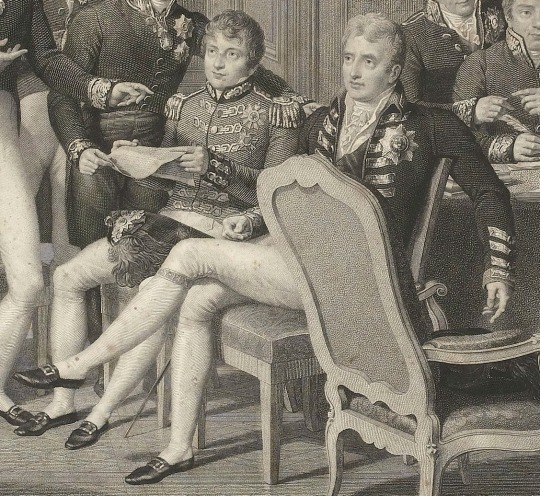
The light shining through the window, however, falls onto Talleyrand, sitting across the table with his dress sword at his side. An empty chair on both his right and left make him further stand out, as do the nearby figures who look to him, just as many of the smaller powers had sought his leadership the last few months.

As Isabey was putting the finishing touches to his composition, he had to figure out what to do about the fact that the Duke of Wellington was now also in town. Starting over was out of the question. Omitting a man of his stature was equally impossible. Yet it was not easy to incorporate him into a canvas on which all the best places had already been taken. The painter's solution was simple and elegant: why not make the painting commemorate the Duke of Wellington's arrival in Vienna?
That way, the duke could simply be inserted on the far left side of the painting, without any insult to his position. As for the duke's reluctance to be painted from a side angle (he was self-conscious about his nose), Isabey had overcome that with a well-targeted compliment: didn't Wellington look like the handsome and chivalric Henry IV? Pleased with this comparison, Wellington accepted, joking that Isabey was a "good enough diplomat to take part in the Congress".
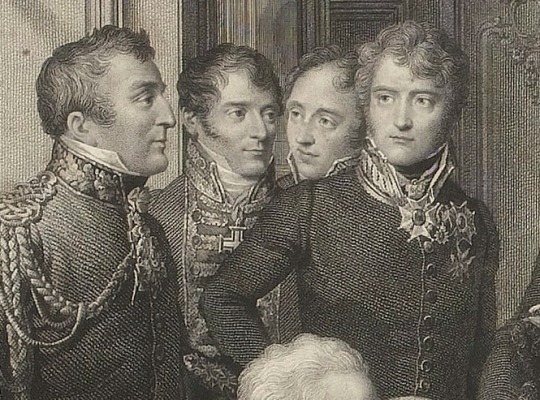
The painter also had to apply his finesse to convince Humboldt to enter the studio. The Prussian ambassador hated to have his portrait made, and, sure enough, he first declined, claiming that he had "too ugly a face ever to spend a penny" on a portrait. With this statement, Isabey saw his opportunity and emphasized that he would not "ask the slightest recompense for the pleasant trouble I am going to take". Isabey only wanted "the favor of a few sittings".
"Oh, is that all?" Humboldt quickly came around when he realized it would not cost him anything. "You can have as many sittings as you like".
Later, many congratulated Isabey on his portrait, particularly the fine job with Humboldt. The Prussian did not pay anything, as agreed, and Isabey got his revenge, Humboldt joked, by painting "an excellent likeness of me".
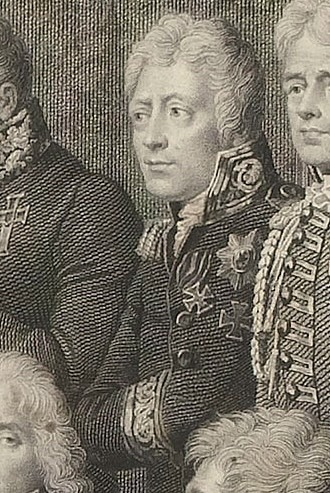
Few could complain of the treatment received from Isabey's flattering brush. This famous painting of the Congress of Vienna was pleasing to all, though typical of this peace conference, the scene was purely imaginary. The group of twenty-three delegates had never met in exactly this way before. Isabey had painted the portraits of each figure individually, and then later assembled the whole group together.
And so, symbolically, this simulated image would commemorate a congress that never was.
After that spectacular depiction of historical context surrounding Isabey’s magnificent canvas by David King few things are left to be added. I would simply love to highlight some other figures of utmost importance for the diplomatic life of that illustrious historical period - there are
Karl August von Hardenberg, Prime Minister of Prussia at the time;
Herren Wacken and Friedrich von Gentz, two Secretaries who were responsible for the protocols of the most important Congress' meetings;
count Karl Vasilyevich Nesselrode, a Russian-German diplomat, who became state chancellor of the Russian Empire in 1816;
prince Andrey (Andrew) Kirillovich Razumovsky, an extremely wealthy Russian aristocrat and diplomat, for whom Vienna was like his second home;
and we shouldn’t (or rather can’t) forget about general Charles Stewart-Vane, Castlereagh’s younger brother who definitely knew how to throw an unforgettable party, so refined aristocratic society could discuss his wild adventures at their fashionable salon meetings day and night. ✨


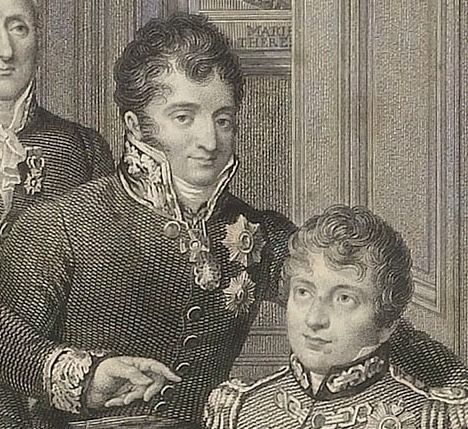
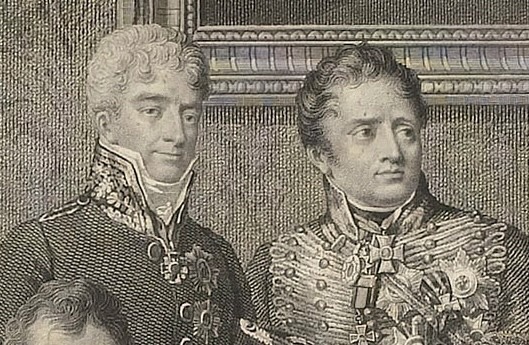
P.S.
Perhaps, there should be more posts with other details of the lithograph as well as Isabey’s original canvas, I’ll just need some time and motivation for that. 👌
#I bet some people know perfectly well what was playing in the background during the arrangement of this post 🤫#the congress of vienna#klemens von metternich#metternich#robert stewart#lord castlereagh#charles-maurice de talleyrand-périgord#talleyrand#wilhelm von humboldt#humboldt#hardenberg#friedrich von gentz#nesselrode#prince razumovsky#charles stewart-vane#napoleonic era#napoleonic wars#19th century#1814#1815
49 notes
·
View notes
Text

Our language, our world
... Wilhelm von Humboldt (1767-1835). Humboldt endorsed an element of linguistic determinism – that is, that language not only reflects a particular worldview but is actively involved in shaping it: ‘Language,’ he wrote , ‘is the forming organ of thought.’ The relationship he envisaged, however, was not one-way but dialectic. Between language and thought there inheres an endless feedback loop: our thoughts shape our words, and our words shape our thoughts. His account was not restricted to individual words – more important were the grammatical structures exhibited in the languages of the world. But even the study of grammar was only a preliminary to the real task, according to Humboldt. Grammar and vocabulary merely represent the ‘dead skeleton’ of a language. To capture its character, to see its ‘living structure’, we must appreciate its literature, the use made of the language by its most eloquent speakers and writers...
- by James McElvenny
- Edited by Sam Dresser published on aeon.co
9 notes
·
View notes
Text
continuing down the road of posting unpolished stuff, I offer you the following. The idea was revealed to me in a dream after watching Die Vermessung der Welt and an episode of The White Lotus on the same day. There’s the scene in dVdW at the deathbed of Wilhelm and Alexander’s mother which my brain immediately connected to the funeral scene of Tanya‘s mother in The White Lotus.
Long story short: Wilhelm von Humboldt gets emotional during his mother’s funeral. Alexander and Aimé are there as well, so is Goethe who offered emotional support to his friend. Faces may look weird because I‘m not skilled at expressions yet, and Jennifer Coolidge‘s acting is truly sth else <3
I‘m so sorry <3

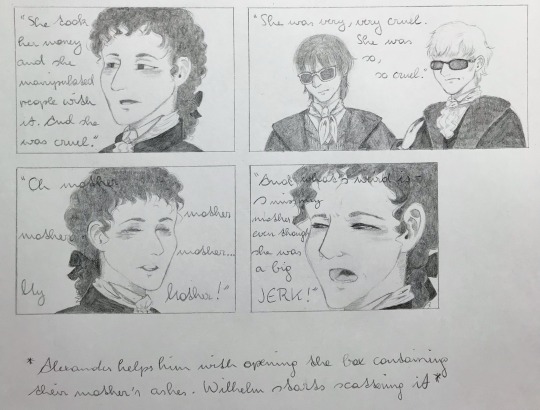
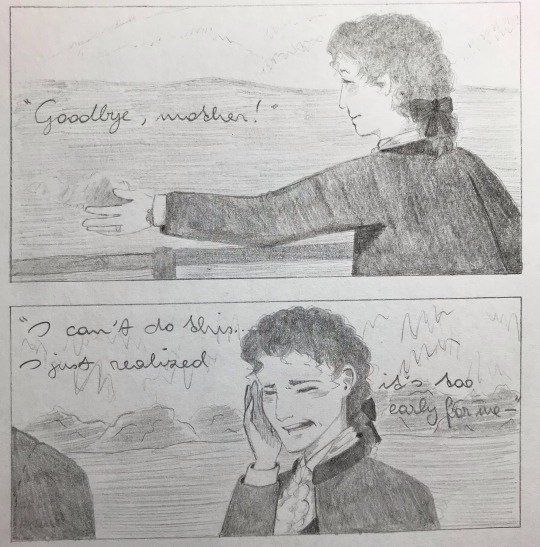

Reference + script (and maybe context?) under the cut
youtube
Text:
„My poor mother…she died in June.
My poor mother, she had a beautiful house in Carmel. And she tried very, very hard to be a really good mother. Even though she didn’t have any maternal instincts…or skills.
She took her money and she manipulated people with it. And she was cruel. She was very, very cruel. She was so, so cruel. Oh mother, mother, mother. My mother!
And what’s weird is- I miss my mother even though she was a big jerk!“
*Alexander helps him with opening the box containing their mother’s ashes. Wilhelm starts scattering it.*
„Goodbye, mother!
I can’t do this…I just realised it’s too early for me-
AAAAAAHHHHHH“
#die vermessung der welt#wilhelm von humboldt#alexander von humboldt#aime bonpland#botany boyfriends#und aja#johann wolfgang von goethe#ist auch da#Youtube#marlowe draws
9 notes
·
View notes
Text
“Nobody means by a word precisely and exactly what his neighbour does, and the difference, be it ever so small, vibrates, like a ripple in water, throughout the entire language. Thus all understanding is always at the same time a not-understanding, all concurrence in thought and feeling at the same time a divergence.”
— Wilhelm Von Humboldt, Humboldt: ‘On Language’. (trans. Peter Heath)
4 notes
·
View notes
Text

«La falta de madurez para la libertad sólo puede brotar de la carencia de fuerzas intelectuales y morales; sólo laborando por suplir o elevar estas fuerzas se puede contrarrestar aquella carencia, mas para ello es indispensable ejercer esas fuerzas, y este ejercicio requiere libertad, la cual despierta la independencia. Claro está que conceder libertad no significa precisamente liberar de ataduras a quien no las siente como tales. Pero no es éste el caso con ningún hombre en el mundo, por desasistido que se halle de la naturaleza o degradado por su situación. Por consiguiente, hay que desligar al hombre de sus ataduras gradualmente y a medida que se vaya despertando en él el sentimiento de la libertad, y cada nuevo paso acelerará el progreso.»
Wilhelm von Humboldt: Los límites de la acción del Estado. Editorial Tecnos, págs. 194-195. Madrid, 2009.
TGO
@bocadosdefilosofia
#wilhelm von humboldt#humboldt#barón de humboldt#guillermo de humboldt#los límites de la acción del estado#libertad#independencia#progreso#madurez#intelecto#moral#fuerzas intelectuales#fuerzas morales#naturaleza#situación#sentimiento de libertad#naturaleza humana#ser humano#libertarismo#época contemporánea#teo gómez otero#thomas lawrence#royal collection
5 notes
·
View notes
Link
FRIEDRICH WILHELM CHRISTIAN KARL FERDINAND VON HUMBOLDT WAS A PRUSSIAN PHILOSOPHER, LINGUIST, GOVERNMENT FUNCTIONARY, DIPLOMAT, AND FOUNDER OF THE HUMBOLDT UNIVERSITY OF BERLIN, WHICH WAS NAMED AFTER HIM IN 1949.
4 notes
·
View notes
Text
youtube
TODAY IN PHILOSOPHY OF HISTORY
Wilhelm von Humboldt and the Historian’s Task
It is the 257th anniversary of the birth of Wilhelm von Humboldt (22 June 1767 – 08 April 1835), who was born in Potsdam, then part of the Margraviate of Brandenburg, on this day in 1767.
Wilhelm von Humboldt, like his equally famous younger brother, Alexander von Humboldt, was a man of wide learning who synthesized many forms of scholarship in his works. He was a philosopher, a linguist, and an educational reformer whose influenced rippled over Europe, often indirectly.
Quora: https://philosophyofhistory.quora.com/
Discord: https://discord.gg/r3dudQvGxD
Links: https://jnnielsen.carrd.co/
Newsletter: http://eepurl.com/dMh0_-/
Text post: https://geopolicraticus.substack.com/p/wilhelm-von-humboldt-and-the-historians
Video: https://youtu.be/7GQWjH8wRDM
Podcast: https://spotifyanchor-web.app.link/e/HyiSWSejDKb
#philosophy of history#youtube#civilization#Wilhelm von Humboldt#educational reform#linguistics#Youtube
0 notes
Text
Schlegel: Fighting with my brother about which fruit would win if they were sentient and could fight.
Kleist: Obviously pineapple.
Achim: Except coconut would kick its ass...
Heine: Uh...have you seen a durian before?
Schiller: Dragonfruit is the obvious right answer.
Goethe: That's ridiculous. Pomegranate is known as "grenade" in many languages, e.g. "grenade" in French, "grenade apple" in Swedish...
Bettine: Grapefruit, duh.
Fichte: Obviously the kiwi, as it's the only fruit that can fly. I mean, how would you even fight back?
Humboldt: But kiwis don't fly. Neither the birds nor the fruit.
Tieck: Tomato obviously. It would be hanging out with the vegetables and no one would notice until the other fruits kill each other off, then it swoops in and claims victory.
Brentano: Pumpkins are pretty tough.
Eichendorff: Jackfruit. Have you ever seen those fuckers?
Kleist: CAN'T YOU SEE FRUIT VS. FRUIT BATTLES ARE TEARING US ALL APART?!?!?!?!?!
*everyone arguing*
Novalis: Grapes.
*everyone stops and looks in Novalis's direction*
Novalis: What? They're like a...little...purple...gang.
#source: reddit#and also a matt rose video on youtube#august wilhelm schlegel#heinrich von kleist#achim von arnim#heinrich heine#friedrich von schiller#johann wolfgang von goethe#bettine brentano#johann gottlieb fichte#alexander von humboldt#ludwig tieck#clemens brentano#joseph von eichendorff#friedrich von hardenberg#incorrect german romanticism quotes
9 notes
·
View notes
Text
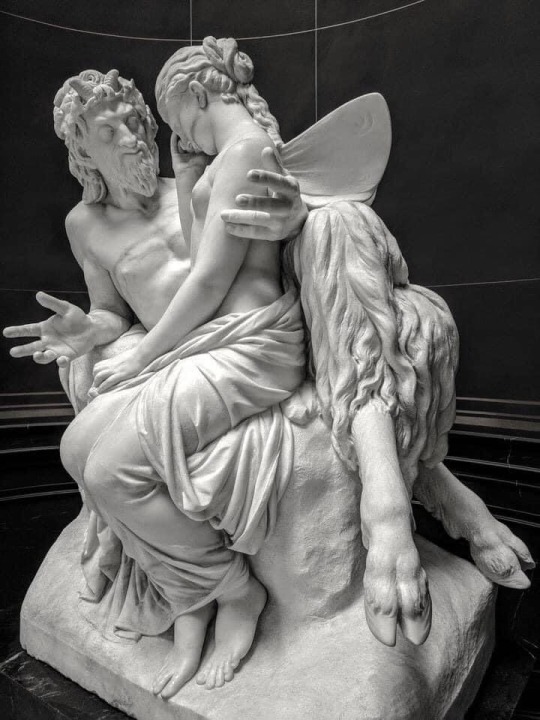
Pan Comforting Psyche (1857-58) “Marble, 101 x 132 x 67 cm” [Alte Nationalgalerie, Berlin, Germany] -- Reinhold Begas (German; 1831 - 1911)
Deserted by Amor, her lover, Psyche bemoans her curiosity and its consequences. Agitated yet demure, she is comforted by Pan, the otherwise frivolous god of nature. The subject allowed Begas to unite a range of contrasts within one sculpture: female/male, tender/rough, youthful/old.
Reinhold Begas was a German sculptor. He was an apprentice under Christian Daniel Rauch and Ludwig Wilhelm Wichmann. From 1856 to 1858 he travelled around Italy where he was influenced by Arnold Böcklin and Franz Lenbach to move towards a naturalistic style in sculpture. In 1861 he was appointed professor at the Weimar art school before winning the competition to create the statue of Schiller at Gendarmenmarkt in Berlin. From 1870 he was the leading artist working in the plastic arts in the Kingdom of Prussia. His artworks dominated the urban landscape, particularly of Berlin, during the German empire. Several sculptures in Berlin bear testament to his high reputation, such as the Neptune fountain in bronze, originally erected on Schlossplatz, the figure of Alexander von Humboldt in front of the Humboldt-Universität or the statue of Otto von Bismarck in the city’s.
Source: Google Arts & Culture
522 notes
·
View notes
Text

Wilhelm von Humboldt, «Introducción a la traducción del Agamenón de Esquilo (1816)» en Miguel Ángel Vega (ed.), Textos clásicos de teoría de la traducción. Traducción de Miguel Ángel Vega.
#wilhelm von humboldt#introducción a la traducción del agamenón de esquilo#textos clásicos de teoría de la traducción#miguel ángel vega
10 notes
·
View notes
Text
En el fondo son las relaciones con las personas lo que da sentido a la vida.
Karl Wilhelm Von Humboldt (1767-1835)
#frases#textos#citas de escritores#escritos#citas cortas#letras#fragmentos#enseñanza#citas#notas#sentimientos#palabras#escrituras#notas cortas
100 notes
·
View notes
Text
We have finally reached the end of the first round, reducing our 128 person list to 64.
Here is the complete list of who is competing in round 2:
France:
Jean Lannes
Thérésa Tallien
Antoine Charles Louis de Lasalle
Germaine de Staël
François Joseph Lefebvre
Géraud Duroc
Étienne Jacques-Joseph-Alexandre Macdonald
Auguste François-Marie de Colbert-Chabanais
Thomas-Alexandre Dumas
Juliette Récamier
Louis-Francois Lejeune
Louis-Alexandre Berthier
Michel Ney
Joseph Fouché
Nicolas Charles Oudinot
Auguste Frédéric Louis Viesse de Marmont
Jean-Andoche Junot
Josephine de Beauharnais
Andrea Masséna
Joachim Murat
Pauline Bonaparte, Duchess of Guastalla
England:
Richard Sharpe
Tom Pullings
Benjamin Bathurst
Horatio Nelson
Barbara Childe
Robert Stewart, 2nd Marquess of Londonderry (Lord Castlereagh)
Captain Jack Aubrey
Horatio Hornblower
Admiral Edward Pellew
Arthur Wellesley, 1st Duke of Wellington
Emma, Lady Hamilton
Scotland:
Thomas Cochrane
Ireland:
Doctor Stephen Maturin
Austria:
Friedrich Bianchi, Duke of Casalanza
Klemens von Metternich
Marie Louise
Wilhelmine von Biron
Archduke Karl
Poland:
Wincenty Krasiński
Józef Zajączek
Zofia Czartoryska-Zamoyska
Józef Antoni Poniatowski
Maria Walewska
Russia:
Prince Andrei Bolkonsky
Levin August von Bennigsen
Pavel Stroganov
Barclay de Tolly
Ekaterina Pavlovna Bagration
Alexander Andreevich Durov
Karl Wilhelm von Toll
Mikhail Miloradovich
Alexander I Pavlovich
Empress Elizabeth Alexeievna
Pyotr Bagration
Prussia:
Louise von Mecklenburg-Strelitz
Frederick William III
Friederike of Mecklenburg-Strelitz
Alexander von Humboldt
Dorothea von Biron
The Netherlands:
Ida St Elme
Spain:
Juan Martín Díez
José de Palafox
Lombardy:
Alessandro Manzoni
22 notes
·
View notes
Text
THIS DAY IN GAY HISTORY
based on: The White Crane Institute's 'Gay Wisdom', Gay Birthdays, Gay For Today, Famous GLBT, glbt-Gay Encylopedia, Today in Gay History, Wikipedia, and more …
September 14



1306 – France: Philip IV orders the arrest of two Knights Templar because they exchanged an obscene "kiss" that pretty much covered their entire bodies.


1769 – Alexander von Humboldt, German naturalist and explorer, born. (d.1859); The younger brother of the Prussian minister, Wilhelm von Humboldt (1767-1835), Alexander von Humboldt's work on botanical geography is considered foundational to the fields of biogeography, physical geography and meteorology. He is a prime example of a Renaissance man of the sciences, studying in astronomy, vulcanology, and geology. Thomas Jefferson called him, The most important scientist I ever met. 19th century Freethinker, Robert G. Ingersoll said, "He was to science what Shakespeare was to the drama."
In the 19th Century, Alexander von Humboldt was one of the most famous men in Europe and is remembered for not only his own scientific achievement, but for his nurturing and mentoring of young, up-and-coming scientists. The American painter Rembrandt Peale painted him, between 1808 and 1810, as one of the most prominent figures in Europe at the time.
Between 1799 and 1804, Humboldt traveled extensively in Latin America, exploring and describing it for the first time in a manner generally considered to be a modern scientific point of view. His description of the journey was written up and published in an enormous set of volumes over 21 years. He was one of the first to propose that the lands bordering the Atlantic Ocean were once joined (South America and Africa in particular). His five-volume work, Kosmos (1845), attempted to unify the various branches of scientific knowledge. In Voyage of the Beagle, where Darwin describes his own scientific exploration of the Americas, Darwin says "He was the greatest traveling scientist who ever lived. I have always admired him; now I worship him."
Much of Humboldt's private life remains a mystery because he destroyed his private letters. In 1908 the sexual researcher Paul Näcke, who worked with outspoken gay activist Magnus Hirschfeld, gathered reminiscences of him from people who recalled his participation in the homosexual subculture of Berlin. A travelling companion, the pious Francisco José de Caldas, accused him of frequenting houses where 'impure love reigned', of making friends with 'obscene dissolute youths', and giving vent to 'shameful passions of his heart'.
On the question of homosexuality, author Robert F. Aldrich concludes, "As for so many men of his age, a definite answer is impossible." But throughout his life Humboldt formed strong emotional attachments to men. In a letter to Reinhard von Haeften, a soldier, he wrote: "I know that I live only through you, my good precious Reinhard, and that I can only be happy in your presence."


1954 – Michael Patrick King is an openly gay, Emmy winning director, writer and producer for television shows. He started out doing stand-up and sketch comedy comedy but eventually moved into writing for television.
His most famous work has been for Sex and the City where he wrote all the season finales and premieres since the second season. King has also recently directed the show's film adaptation.
He has also written for another HBO show, Lisa Kudrow's post-Friends project The Comeback, and as well as for broadcast shows Will & Grace, Cybill, and Murphy Brown. He owns Arcade Productions.


1954 – David Wojnarowicz (d.1992) was a gay painter, photographer, writer, filmmaker, performance artist, and activist who was prominent in the New York City art world of the 1980s. The first American gay artist to respond to the AIDS crisis with anger and moral outrage, he used his art as a polemical tool with which to indict those he held responsible for the AIDS epidemic and to document his own suffering.
Wojnarowicz had no extensive formal training. Born in Red Bank, New Jersey into a severely dysfunctional family in 1954, he dropped out of high school soon after acknowledging his homosexuality as an adolescent. He was a street kid in New York City at the age of sixteen, turning tricks in Times Square and keeping company with hustlers and other outsiders.
Wojnarowicz found salvation in making art and writing. Yet the rawness of his life experiences would always be the stuff of a highly personal and confrontational art.
As a young man, Wojnarowicz hitchhiked across the United States and lived in San Francisco and Paris for several months. In 1978, he settled in New York. By the early 1980s he had become, like graffiti artists Jean-Michel Basquiat and Keith Haring, a vital fixture in the East Village art scene in lower Manhattan.
Wojnarowicz came to maturity as a contemporary artist and writer during a decade when the arts sought increasingly to address issues of gender, race, and ethnicity. A younger postmodern generation of artists gave expression to these concerns in non-traditional media and often worked in multimedia. For example, Wojnarowicz expressed himself in film, installation art, sculpture, photography, performance art, painting, collage, drawing, and writing. Indeed, he became as fine a writer as he was a visual artist.

Before being diagnosed HIV-positive in 1987, Wojnarowicz tracked in his confessional art a life that vacillated between sensual abandon and despair, bringing into focus a dark vision of existence that drew upon the examples of Arthur Rimbaud and Jean Genet.
With the onset of his disease, Wojnarowicz turned fiercely political. The tragedy and injustices of the AIDS epidemic within the gay community became the central subject in his art and writings. He took to task the medical community and the federal government for their indifference to the pressing health issues of gay men. He passionately protested the fact that, as he put it, so many people were dying 'slow and vicious and unnecessary deaths because fags and dykes and junkies are expendable in this country'.

Wojnarowicz was the first American gay artist to step forward in anger and give expression to his moral outrage. His 'post-diagnostic art', as he called it, indicted all those he held responsible for the social and private horrors of those dying from AIDS, including himself. Toward the end of his life, his defiant art was a polemical and poignant record of his cruel demise.
Wojnarowicz died of AIDS on July 22, 1992.


1957 – Steven Jay Russell is a U.S. con artist known for escaping from prison multiple times. A film about his life and crimes was produced in 2009, named I Love You Phillip Morris. In 2011, his crimes were featured on the TV show I Almost Got Away with It in the episode "Got a Boyfriend to Support.". He is known to be the only con artist in the world serving a life sentence (since he is sentenced to 140 years). A documentary about his crimes was aired on TV in 2005 On The Run episode "King of Cons" on Discovery Channel.

Russell's life of crime started in the early 1990s when he was fired from his job as an executive of a food service company after his employers found out he was gay. He was later arrested for fraud for faking a slip-and-fall accident, and was sentenced to six months in prison. After serving four weeks in jail, Russell escaped by using a spare set of civilian clothes and a walkie talkie to impersonate a guard. He later went to take care of his boyfriend Jimmy Cambell who was dying of AIDS; Cambell died three weeks after Russell was re-arrested and sent back to Harris County jail.
In prison Russell met Phillip Morris, whom he quickly fell in love with. The two were later released from prison, and wanting to give Morris a glamorous lifestyle, Russell managed to get a job as the chief financial officer of the North American Medical Management Company (NAMM). He then started embezzling funds, stealing $800,000 before the activity was detected and Russell and Morris were arrested.
Sent back to the Harris County jail, Russell, considered a flight risk, had his bail set at $950,000, but later made his next escape by calling the Harris County Records Office, pretending to be a judge, and lowering his bail from $950,000 to $45,000 before posting the reduced bail. He was arrested in a hotel room in West Palm Beach, Florida one week after his second escape.
Russell was sentenced to 40 years in prison for the NAMM fraud and was sent back to prison. Russell concocted a new escape after he began collecting green highlighter markers and a spare prison uniform and used his cell toilet to dye the uniform green to look like doctor's scrubs. He then walked out of the front door. After tracking down Morris, he convinced him to run with him and the two fled to Biloxi, Mississippi, making money in casinos, where Russell was later identified and arrested by a U.S Marshal. Morris was also quickly found and arrested.
He was sent back to a maximum security prison in Texas to serve an additional 45-year sentence. From here, Russell made his most inventive escape ever; he used acting and laxatives to fake the symptoms of AIDS, and a prison typewriter to fake his medical records to show him as HIV positive, being granted a special-needs parole to a nursing home to die. He then called the prison and parole board, posing as a doctor and AIDS specialist, asking for prisoners interested in an experimental treatment, and volunteered. Once out of Texas, he then sent death certificates to the prison and parole board stating he had died.
U.S. Marshals later tracked Russell down in Florida where they arrested him once more. Russell was then sentenced to a total of 140 years in prison (119 for the escapes and subsequent scams).
His release date from prison is July 12, 2140.


1978 – Heterosexual Ben Cohen, MBE is an activist and former England rugby union international player. He began his professional career with Northampton Saints in 1996; in 2007 he moved to France to represent Brive before returning to England two years later to join Sale Sharks. In May 2011, Cohen retired from professional rugby, and will focus on The Ben Cohen StandUp Foundation he created to combat homophobia and bullying.
In November 2000, Cohen's father Peter Cohen, brother of English World Cup winning football player George Cohen, was fatally injured while protecting an attack victim at the Eternity nightclub in Northampton which Peter Cohen managed. He died a month later from head injuries sustained in the assault. Three men were found guilty of violent conduct.
Cohen wass married to Abbie Cohen (Blayney), with twin children. The couple have been estranged since 2014, and divorced in March 2016. In January 2016 it was announced, his former Strictly Come Dancing dance partner and now girlfriend, Kristina Rihanoff, will be expecting their first child together.
He is clinically deaf, with about 30 to 33 percent hearing loss in each ear, and has been involved in efforts to make rugby more accessible to the hard of hearing, especially younger deaf players.
In 2011, Cohen founded The Ben Cohen StandUp Foundation, Inc., which is, according to its website, "the world's first foundation dedicated to raising awareness of the long-term, damaging effects of bullying, and funding those doing real-world work to stop it".

Off the field he is considered a gay icon, and often speaks favourably of his gay following. He ousted David Beckham as Gay Times' sports personality of the year in 2008, and came second as their sexiest man of the year. Among other Ben Cohen merchandise, he has released calendars since 2009 in which he is often shirtless. Ben appeared on the cover of Attitude's October 2009 issue.
In 2010, Cohen donated a signed jockstrap to support GMFA, a British charity addressing gay men's health issues, which was sold at auction at the Royal Vauxhall Tavern. He also featured on the front cover and in an interview section of GMFA's printed FS Magazine in November 2010.


2000 – Five police officers raid Pussy Palace, a women's bathhouse event in Toronto. No charges were laid against customers, although police recorded the names of ten women, and two organizers, Rachael Aitcheson and J.P. Hornick, were charged under the bawdyhouse law. Subsequent protest action characterizes the event as essentially little more than a panty raid; and a march on the offices of the Toronto Police Services' 52 Division on October 28 featured protestors waving underwear in the air.
Police estimate some 125 women and men — swinging their boxers, sober cotton undies, raunchy red lingerie and bustiers — showed up at the Oct 28 Panty Picket protest in front of 52 Division.
"Fuck you 52" was one of the chants — hearkening back to a slogan from the 1981 bathhouse raids, where police destroyed hundreds of thousands of dollars in property and arrested more than 300 gay men in a carefully orchestrated raid of Toronto bathhouses.
The demo protested the hour-and-a-half-long raid on the Pussy Palace — filled with 300 women — by the five male plainclothes police officers on what they call a "routine liquor inspection" and what the women call harassment.
One picket sign read "Sluts can't be shamed," and props included a giant vulva and a clothesline of lacey underthings.
A call and reply went: "What do we want?"
"Pussy!"
"When do we want it?"
"Now!"
Even the cops laughed — at least 18 of whom lined the entrance to 52 Division during the protest.


11 notes
·
View notes
Note
I loveee your post about how Nandor isnt really a dumbass! however I was just watching the ep where they go to Atlantic city and nandor still thought the world was held up by four elephants? How could this map into what you've explained in the post?
Unfortunately that is one of the holdouts that I have trouble with lol.
That being said, the four elephants is actually a misnomer that came later? Originally in Hindu cosmology (yes I went to Wikipedia for this, because my trivia knowledge is good... but sadly it's not that good lol) it's eight male elephants and eight female elephants that represent the eight 'zone' of the Universe. So, sixteen elephants! There's no mention of a turtle at that point either.
We can surmise that Nandor may have heard that belief at some point in his human life. But, I don't know if he would have taken it literally? At that point he might have just marked it down and didn't think on that part much further.
But here's where it gets interesting.
The idea of four elephants on the back of a turtle? That doesn't come around until 1599. In a letter by Emanual de Velga, Wilhelm von Humboldt (who was a linguist among other things) suggested that the idea of elephants may be from a misinterpretation of the Sanskrit word Nâga, being that it can refer to both "serpent" and "elephant" (because of the snake-like trunk). He suggests that through misinterpretation, the idea of the elephants actually comes from the idea of the World Serpent - such as Jörmungandr in Norse mythology.
Now, he did write that with absolutely zero proof, but that does open up another line of questioning for us.
It's known that the Vikings made their way all the way to the Holy Land. There are stories that they helped the Knights Templar during the Crusades.
Now, Nandor was Supreme Viceroy in a part of Persia. That's pretty removed, geologically speaking, from where the Crusades were being waged. Though, the Ninth Crusade, from 1271 to 1272, would have been being waged when he was a little boy. And word travels.
I am going to suggest, perhaps, that one of his tutors when he was a young boy, was either a Norseman himself, or had at least encountered the Vikings at some point in his history. After all, people travel, ideas travel.
So maybe Nandor was taught the idea of Jörmungandr, not necessarily as a fact, but while his teachers were telling him stories. He's somewhere between eight and ten years old, and the idea latches on. It takes his fancy, but he also misinterprets the the meaning of 'serpent', because he's a child who has been also taught some of the Hindu cosmology, as part of his lessons, to open his mind.
So, now two different cultures have taught him that there's "elephants" holding up the world.
And then, he's a Vampire, and he's able to travel to places he'd never dreamed of as a boy. Places he didn't know existed. Like the New World.
And the Indigenous people here tell him the story of Sky Woman, and the great Turtle that is Turtle Island - North America. And it all clicks together! Another culture that believes in the world either being, or being supported by, a turtle!
Even though those lovely people didn't mention elephants, they must be there! They're there in all the other beliefs!
I suggest that Nandor just... learned the mythology at a very young age, and it gripped him.
Sure, he would have learned Empedocles and Anaxagoras' arguments that the Earth was a sphere and not flat - it would have been included with both his Classics lessons and his arithmetic lessons. And probably history lessons.
But, he never questioned that, did he? He drew a spherical earth held by the elephants. So yes, he absolutely learned that the Earth is round, and not flat. He absolutely learned everything that the Ancients had already discovered about the Earth's place in the Universe. But he also believed that the sphere was held up by the elephants and rode the back of a great turtle.
And then came Copernicus, in the early to mid 1500s, who suggested that the Sun, rather than the Earth, was the center of the universe. Nandor, still educating himself at this time, would have read this theory and probably immediately found it sound.
Of course the Earth moves around the Sun! It's on the back of a turtle! And that's why it takes a year! Turtles are very slow!
I think Nandor's belief in the World Elephants (and turtle) are less about a failure of his education, and less about his intelligence, and more about one of those long-held beliefs of childhood. Because it fascinated him as a child, even if it was just a myth. It just... he liked the idea and then it just sort of cemented itself in his mind.
And, when he stopped seeking out further knowledge, he missed the advancements in astronomy etc. I think learning about the Big Bang as the theories developed would have fascinated him, rather than having it all dumped on him one evening by Colin Robinson.
Poor man had his entire childhood and worldview eradicated in one blow.
#nandor the relentless fanart#wwdits nandor#long post#about Nandor's education#World Elephants#World Turtle#what we do in the shadows#wwdits
17 notes
·
View notes